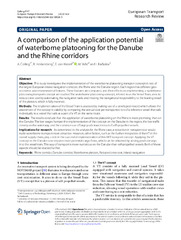Приказ основних података о документу
A comparison of the application potential of waterborne platooning for the Danube and the Rhine corridors
| dc.creator | Colling, A. | |
| dc.creator | Hekkenberg, R. | |
| dc.creator | van Hassel, E. | |
| dc.creator | Vidić, Milica | |
| dc.creator | Bačkalov, Igor | |
| dc.date.accessioned | 2022-09-19T19:28:03Z | |
| dc.date.available | 2022-09-19T19:28:03Z | |
| dc.date.issued | 2022 | |
| dc.identifier.issn | 1867-0717 | |
| dc.identifier.uri | https://machinery.mas.bg.ac.rs/handle/123456789/3711 | |
| dc.description.abstract | Objective This study investigates the implementation of the waterborne platooning transport concept in two of the largest European inland navigation corridors, the Rhine and the Danube region. Each region has different geo-economic and environmental features. These features are compared, and their effects on implementing a waterborne platooning transport concept are studied. The waterborne platooning concept, referred to as the Vessel Train, aims to reduce crew cost by automating the navigation tasks and moving the navigational responsibility to the leading vessel of the platoon, which is fully manned. Methods The implementation of the Vessel Train is assessed by making use of a developed model, which allows the assessment of the concept's viability by comparing the annual cost per transported ton of a reference vessel that sails individually to a vessel that sails as a part of a VT on the same route. Results The results conclude that the application of waterborne platooning on the Rhine is more promising than on the Danube. The low wages hamper the implementation of the concept on the Danube in the region, the low traffic density on the waterway, and the common use of large push tows instead of self-propelled vessels. Implications for research As determined in the analysis for the Rhine case, a reduction in transport cost would make waterborne transport more attractive. However, other factors, such as the further integration of the VT in the overall supply chain, play a role in the successful implementation of this IWT transport concept. Applying the VT concept in the Danube case requires more potential cargo flows, which can be obtained by adding push convoys into the vessel train. This way of transport is more numerous on the Danube than self-propelled vessels. Both of these aspects should be studied further. | en |
| dc.publisher | Springer, New York | |
| dc.relation | info:eu-repo/grantAgreement/EC/H2020/723009/EU// | |
| dc.rights | openAccess | |
| dc.rights.uri | https://creativecommons.org/licenses/by/4.0/ | |
| dc.source | European Transport Research Review | |
| dc.subject | Waterborne platoon | en |
| dc.subject | Rhine corridor | en |
| dc.subject | Reduced crew cost | en |
| dc.subject | Inland navigation | en |
| dc.subject | Danube corridor | en |
| dc.title | A comparison of the application potential of waterborne platooning for the Danube and the Rhine corridors | en |
| dc.type | article | |
| dc.rights.license | BY | |
| dc.citation.issue | 1 | |
| dc.citation.other | 14(1): - | |
| dc.citation.rank | M22~ | |
| dc.citation.volume | 14 | |
| dc.identifier.doi | 10.1186/s12544-022-00526-5 | |
| dc.identifier.fulltext | http://machinery.mas.bg.ac.rs/bitstream/id/2259/3708.pdf | |
| dc.identifier.scopus | 2-s2.0-85125476820 | |
| dc.identifier.wos | 000761283300001 | |
| dc.type.version | publishedVersion |


